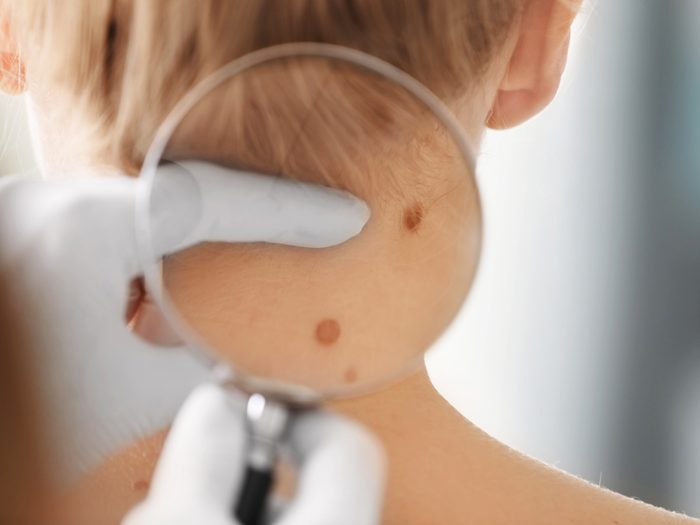
Is it a keloid?
Trying to figure out what bumps on skin can be hard. Keloids occur when scar tissue grows excessively, explains Gary Goldenberg, MD, a dermatologist and an assistant clinical professor of dermatology at the Icahn School of Medicine at Mount Sinai Hospital in New York City. They often form around a wound or incision, but they may appear after a bad bout of acne. “Keloids are red, raised and can be itchy or painful,” he says. They’re more common in darker skin and often show up on the ears, chest, face or back. Many different treatments work alone or together to improve keloid scarring including steroid injections to flatten the scar, cryosurgery to freeze the scar tissue so it sloughs off, laser resurfacing, and surgery, he says. “You do need realistic expectations about how much keloid scarring can be improved with any treatment.”
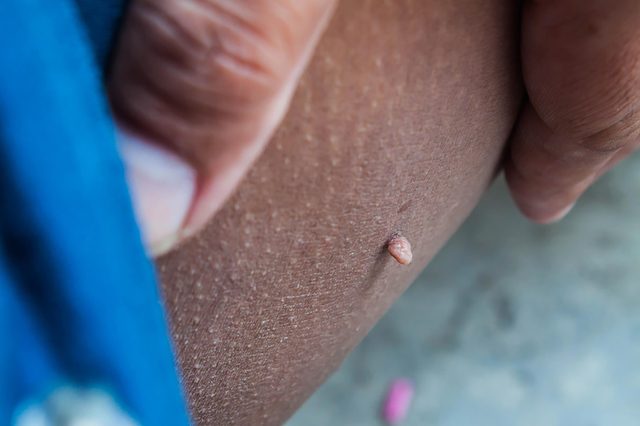
Is it a skin tag?
Skin tags are exactly what they sound like—tiny, soft skin-coloured growths, Dr. Goldenberg says. “They often develop around the eyelids, armpits, groin or other areas that are easily rubbed or irritated.” Medically known as acrochordons, skin tags are more common if you are overweight, pregnant, or have diabetes. They’re also a normal sign of aging skin. They are not harmful in any way, shape or form, he says. “If they bother you, a doctor can freeze, laser, or snip them off.”
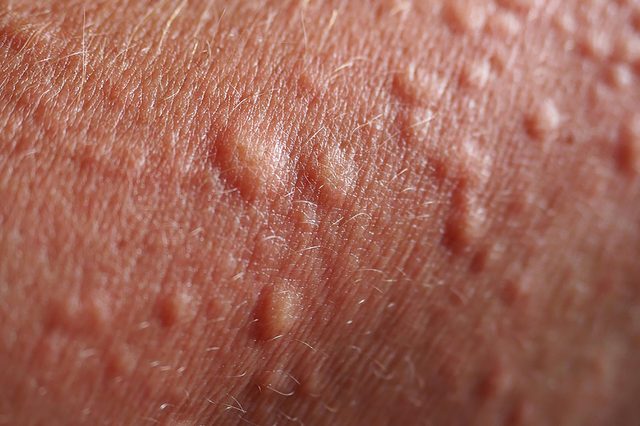
Is it a hive?
Do your bumps on skin itch like crazy? Tend to come and go? Get worse at night? If so, it could be a hive, Dr. Goldenberg says. Also known as urticaria, hives are usually a result of an allergy. Viruses can cause hives too, but many times hives are idiopathic in nature, meaning that there is no known cause. This can be extremely frustrating and vexing, he says. “If you know you break out in hives when you eat a certain food or are exposed to a specific chemical, avoid those triggers,” he says. Over-the-counter antihistamines such as Benadryl can also help curb the itching. Talk to your doctor about the best treatment for you.
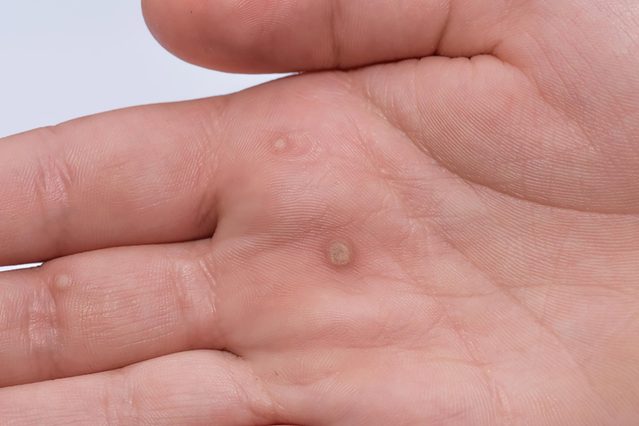
Is it a wart?
Warts are usually small skin-coloured growths that feel rough when you touch them. Some may be sprinkled with tiny black dots. “They are caused by the human papillomavirus (HPV), and often occur on the hands and feet,” Dr. Goldenberg says. They can also show up in the genital area. You can try over-the-counter solutions, or opt for lasers or even surgery. Or try these natural remedies that can help get rid of warts on your face, hands, or feet.
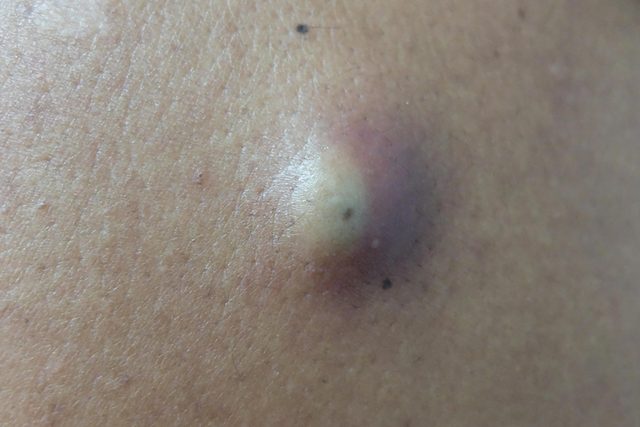
Is it a cyst?
It’s alarming to feel or spot a cyst, but don’t hit the panic button. Cysts are harmless, closed pockets of tissue filled with fluid, pus, or another material. “They look and feel like balloon sacs under the skin,” says Dr. Goldenberg. They may disappear on their own, but some cysts may burst or cause symptoms such as pain or itching and require treatment. Whatever you do, “don’t try to squeeze them at home as this creates inflammation and will make things worse,” he warns.
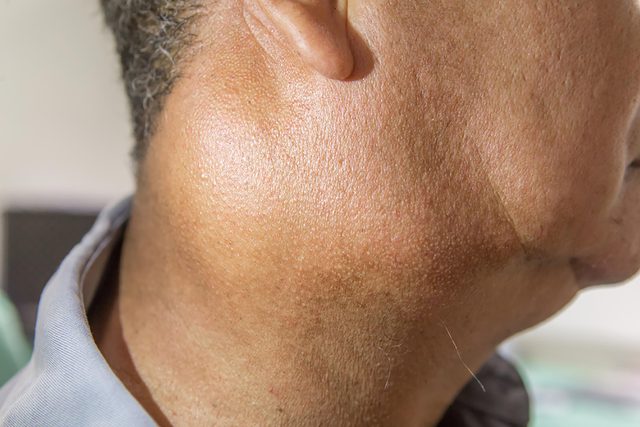
Is it a swollen lymph node?
We have lymph nodes or bean-shaped organs all over our bodies. These super-important glands are tasked with recognizing and fighting germs, infections, and other intruders. If a swollen lymph node appears suddenly as a painful lump under skin, it may be a sign of infection or injury. Slow, painless swelling in the lymph node, however, may be more serious, though you’ll be happy to hear that only rarely are swollen lymph nodes caused by cancer, according to researchers at the Mayo Clinic. Better safe than sorry, though—if you are concerned about a swollen lymph node, see your doctor to find out what is going on. Learn some signs of disease that your skin can reveal.
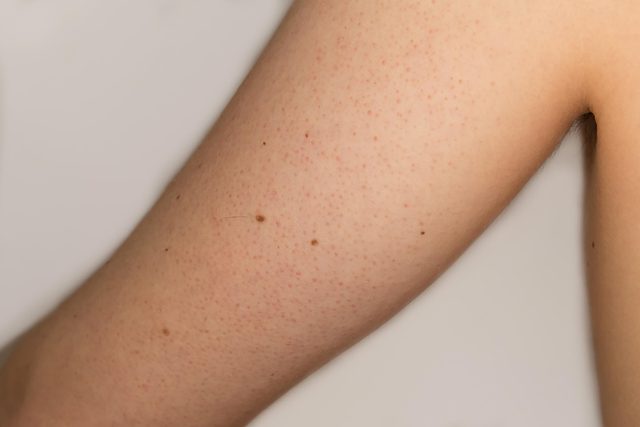
Is it keratosis pilaris?
KP is short for keratosis pilaris and is sometimes called chicken skin. KPs are small, hard and rough bumps on skin of the arms, legs or the butt. They are really just plugs of dead skin cells. “KP is associated with eczema, and doesn’t require treatment unless it is itchy or bothers you,” Dr. Goldenberg says. “Moisturizing with products that contain lactic acid, glycolic acid or salicylic acid can help exfoliate the bumps and smooth skin.” But, he warns, the minute you stop slathering on the cream, the KP will come right back.
Don’t miss these health secrets your hands are trying to tell you.
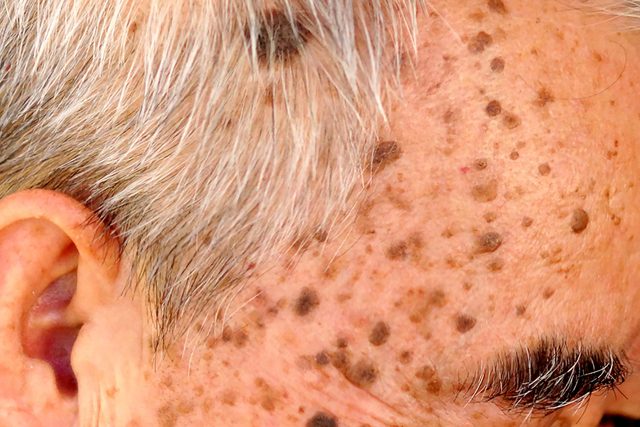
Is it seborrheic keratosis (SK)?
Seborrheic keratosis or SK is an extremely common colored skin growth. They may be beige, brown or even black. “SKs are non-cancerous, but they can look like skin cancer and sometimes may be sent to the lab to be sure,” Dr. Goldenberg says. Marked by multiple small, dark growths that tend to cluster on the face or neck, dermatosis papulosa nigra (DPN) are another form of SK that affects African-Americans and other people with darker complexions. If they bother you, SKs can be frozen, burned, scraped or shaved off, he says.
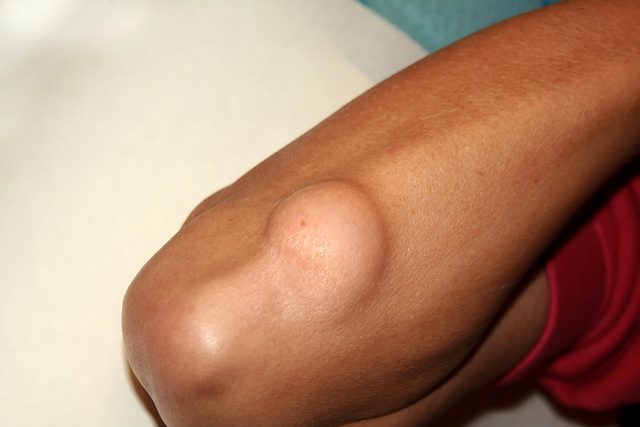
Is it a lipoma?
Lipomas are harmless fatty tumors found under the skin. They feel soft and doughy and are often seen in the neck, shoulders, back, abdomen, arms and thighs. “You can easily move them around, and they may be painful or quite large,” Dr. Goldenberg says. Radiologists can do a simple ultrasound imaging test to diagnose a lipoma. “Surgery, steroid injections and/or liposuction may be options, but no treatment is necessary unless you are bothered by it.” Here are some surprising signs of disease your skin can reveal.
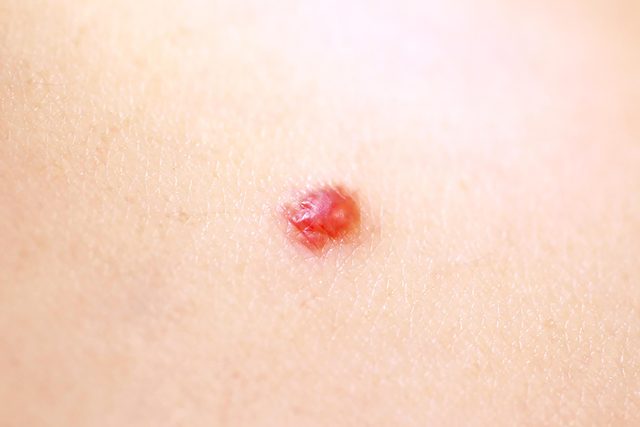
Is it a cherry angioma?
Cherry angiomas are collections of bumps on skin or blood vessels that tend to strike in people 30 or older. As the name suggests, these benign growths are bright cherry-red in color. “They are usually only treated for cosmetic reasons,” Dr. Goldenberg says. Importantly, cherry angiomas are different than hemangiomas sometimes seen in infants, which do require evaluation from a doctor. Here’s what you can expect from a full body skin examination.
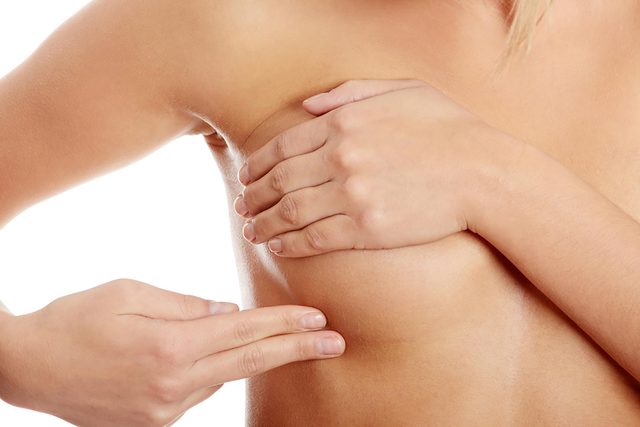
Is it a breast cyst?
Found a lump in your breast? Don’t panic: 85 percent of all breast lumps have nothing to do with cancer. According to Donnica L. Moore, MD, president, Sapphire Women’s Health Group, “Breast lumps are extremely common, which is why it’s important to examine your breasts monthly and know what’s normal for you,” says Dr. Moore. Benign breast lumps are usually round with well-defined edges, freely movable, tender, and may change in size with hormonal ups and downs. “The majority of breast lumps are benign and require no treatment, but it’s always good to have your doctor confirm that! ” Try to make these 10 crucial health tweaks by your 50s for improved health.
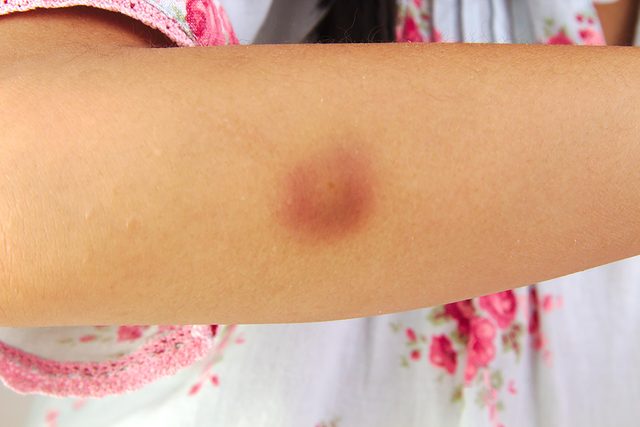
Is it a hematoma?
Ever notice a hard knot or lump in or around a recent bruise? “Don’t worry—this is probably a hematoma,” Dr. Moore says. “Hematomas are composed of a small amount of blood which has pooled into the fatty tissue under the skin,” she says. “While they often feel hard to touch, they may also feel spongy, rubbery or lumpy. They may be mobile, uncomfortable or painful,” she says. These lumps don’t typically require medical attention. “The blood will generally be reabsorbed as the bruise resolves,” she says, Icing the area and elevating it may help. ” (A seroma can be another type of painful lump under the skin that occurs when fluid pools at a surgical site. This is part of the natural healing process, but if seromas cause pain or grow too large, your doctor may need to drain them.)
Should you be taking collagen for your skin? Here’s what to know.
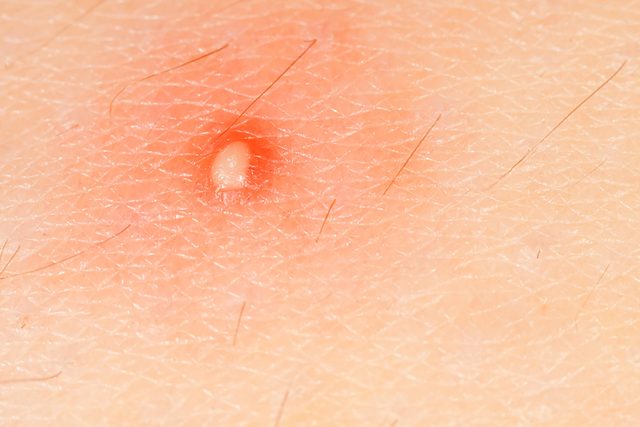
Is it a boil?
A boil is a firm, painful lump that can look like an over-sized pimple. It’s usually caused by an infection of a hair follicle. “Boils may increase or decrease in size, or spontaneously drain, weep, or ooze,” Dr. Moore says. Repeated hot packs or soaking three to four times a day usually helps. In some cases, medical attention is required to lance or drain a boil. “People with cancer, diabetes or other causes of immunocompromised should seek medical attention whenever they develop this or any other skin infection,” she says.
Psst: These are the most (and least) painful places on your body to tattoo.
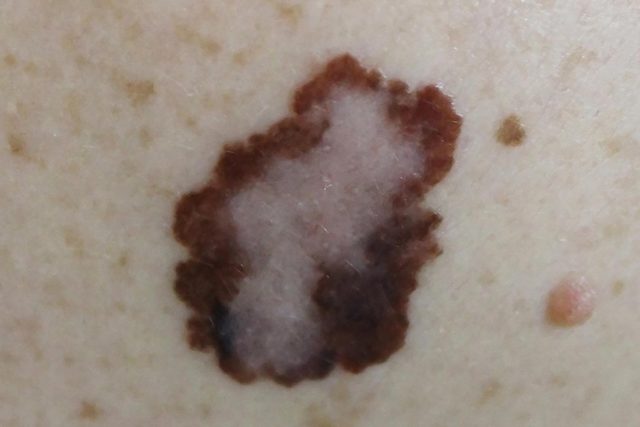
Is it skin cancer?
The sooner skin cancer is diagnosed, the easier it is to treat. According to the Canadian Dermatology Association, the skin cancer cure rate is 90 percent if you regularly check by self-examination. Here’s how to check yourself, and recognize skin cancer if you see it.
